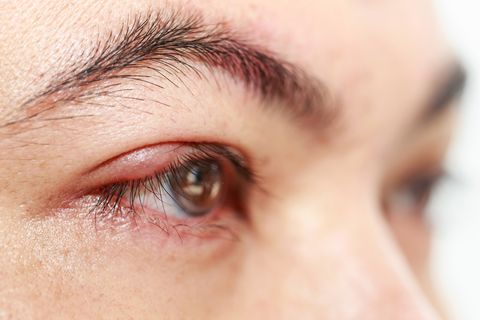
There comes a point in life when you just have to accept that you’re going to get pimples—on your face, on the backs of your arms, even on your butt.
But damn, do they have to show up on your eyelids too?
Hold on—an eyelid pimple? What’s that?
Okay, so it’s not technically a pimple—these eyelid bumps are probably styes (a.k.a. hordeolums), though they could also be something called chalazia, according to the American Academy of Ophthalmology (AAO).
Styes are the most pimple-like—they can be painful, red bumps that have a small pus spot in the center, and they grow at the base of the eyelash or under the eyelid, per the AAO. Chalazia, however, aren’t usually painful and develop on the eyelid itself.
Styes and chalazia are typically caused by the same thing: an infected or clogged oil gland (yep, you have those on your eyelids, just like your skin); styes can also be a result of an infected eyelash.
“Sometimes oils are running thicker and don’t flow out like they’re supposed to, and this oil can’t get out one or more of the openings,” says Preeti J. Thyparampil, M.D., an ophthalmologist and oculoplastic surgeon at Northwestern Memorial Hospital. “The painful bump that develops is an accumulation of this oil.”
Styes and chalazia don’t discriminate—anyone can get them; but you’re more at risk for pimples if you have a skin condition like rosacea or seborrheic dermatitis, or blepharitis (redness or swelling at the base of the eyelashes caused by oils and bacteria), per the AAO.
Okay, how can I get rid of this stye—STAT?
First, definitely don’t wear makeup or contact lenses when you’re dealing with a stye or chalazion, per the AAO—that could only help the infection spread.
After that, help move healing along faster with a warm compress, says Sunir Garg, M.D., clinical spokesperson for the American Academy of Ophthalmology.
Heat helps loosen up the clogged oil, so Garg recommends microwaving a bowl of hot water, then dip a washcloth in the water and hold it onto your closed eyelid. The compress should remain hot the entire time, so keep dunking it and then reapplying. Do this for 10 minutes twice a day for four to seven days.
In that amount of time, it should start getting better, he says. But don’t rush things: A mild but not painful bump (a.k.a. a chalazion) can stick around for several weeks. Oof.
You can also see your ophthalmologist who may want to prescribe topical antibiotic drops, but only use these under the guidance of a doctor, says Garg. Using these on your own can make the situation worse.
Whatever you do, don’t pop that stye, even though it looks like a pimple. For one, it can spread bacteria. Popping can also trigger more inflammation and make the bump worse so that it sticks around longer, says Thyparampil.
Even more concerning: Popping a stye—or a chalazion, for that matter—can cause scarring around the eyelid, something she says can noticeably alter the shape of your eyelid.
When should I be concerned about a stye in my eye?
If it’s been slow growing and the bump has taken several weeks or months to develop, it doesn’t hurt, and it’s rubbery to the touch, something else may be going on, says Garg. In that case, see an ophthalmologist or dermatologist.
One possibility: It might be skin cancer. Five to 10 percent of all skin cancers are located on the eyelid, according to the Skin Cancer Foundation, and it’s possible for people of any age to develop them—eyelids are exposed to the sun, after all, says Garg.
If a bump causes you to lose eyelashes, is getting larger, or is persistently non-healing (meaning it stays scabbed), see your doctor, adds Thyparampil. The same goes for if you experience extreme swelling or pain, the area is warm to the touch, you have a fever, or have vision changes.
But that’s only in rare cases—most of the time, styes and chalazions go away on their own, so deep breaths. Haven’t you been wanting to buy a new pair of sunglasses anyway? Thought so.
Source: Read Full Article
